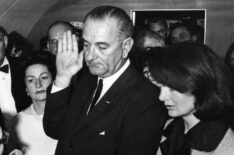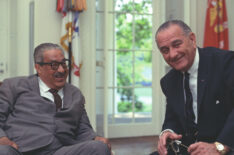Lyndon B. Johnson

Politician
Birth Date: August 27, 1908
Death Date: January 22, 1973 — 64 years old
Birth Place: Stonewall, Texas
Spouses: Lady Bird Johnson
Lyndon Baines Johnson was raised by a rural family whose deeply religious background set the foundation for the wide-reaching social and economic platforms he would later implement as a politician. He was born in Stonewall, Texas, on Aug. 27, 1908, the son of businessman Sam Ealy Johnson Jr. and Rebekah Baines Johnson. Politics seemed to be in the blood - his father was a member of the Texas House of Representatives, as was his maternal grandfather, Joseph Baines.
Despite the family's accomplishments and connections, they struggled to make ends meet, and Johnson needed to take on a series of jobs to finance his education. In 1928, to afford his final classes at Texas State University, Johnson spent nine months teaching young Mexican-American students at a segregated school in Cotulla, Texas. His experiences there solidified his commitment to making education available to everyone regardless of their economic status. After graduating in 1930, he went into teaching.
It wasn't long before Johnson entered the political arena by joining the congressional campaign of Texas State Sen. Welly Hopkins. Hopkins introduced Johnson to Rep. Richard Kleberg, who hired Johnson as his secretary. In 1934, he met Claudia "Lady Bird" Taylor and proposed to her on their first date. They married in November of that year. Finding support and stability in his soul mate, Johnson campaigned for and won a seat in the U.S. House of Representatives in 1937.
He helped to advance President Franklin D. Roosevelt's New Deal policies. He enlisted in the U.S. Naval Reserve as a lieutenant commander and requested a combat assignment. President Roosevelt placed him on a survey team to evaluate conditions in the Southwest Pacific, and Johnson returned with a plan to improve operations and morale. He had two children with his wife: Lynda in 1944 and Luci in 1947. He won election to the Senate in 1948 by a razor-thin vote and served 12 years, ultimately becoming the youngest majority leader in Senate history.
His stern but effective control over the ruling body brought him into John F. Kennedy's presidential campaign, and he joined Kennedy's ticket as the vice presidential nominee. After the assassination of President Kennedy, Johnson became the 36th President of the U.S. on Nov. 22, 1963. He won re-election in 1964 to a full term, throwing his support behind the late Kennedy's agenda on civil rights, ensuring the passage of the Civil Rights Act of 1964 that codified sweeping racial equality measures into law. He agonized over expanding military involvement in the ongoing Vietnam War, determined to stop the spread of Communism, yet aware of the conflict's decreasing popularity among Americans.
Domestically, he stayed true to his roots and launched an agenda to provide better education for children from lower-income families through greater funding of public schools and the issuing of grants and loans. He decided not to seek re-election and retired from the presidency in 1969, moving back to his ranch in Texas, where his health began a rapid decline. He died of a heart attack at his home on Jan. 22, 1973.
Credits

The Best of The Ed Sullivan Show

The Most Dangerous Man In America




